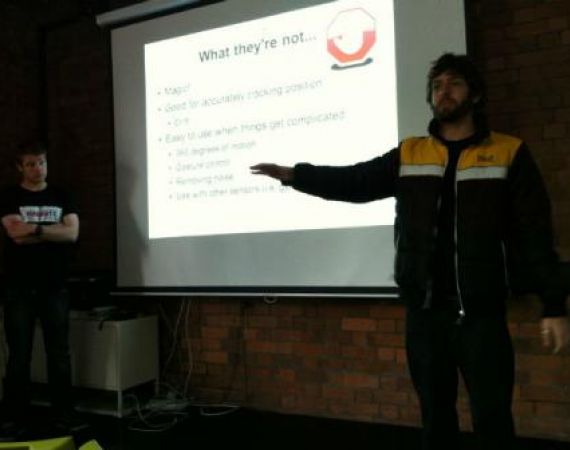Posted on Fri 15 Jun 2012
Lunchtime talk: Accelerometer madness
Dan Newton and Lee Arromba are studio residents and collaborators of Tangible FX who create interesting and useful controls for musically inspired people. Their current iPhone app the iMoov is a Midi controller that allows free axis of movement that the user can control using any sort of parameters…

Dan Newton and Lee Arromba are studio residents and collaborators of Tangible FX who create interesting and useful controls for musically inspired people. Their current iPhone app the iMoov is a Midi controller that allows free axis of movement that the user can control using any sort of parameters within software.
An accelerometer measures acceleration in relation to gravity, this means that you can measure change in speed, vibration and movement. This is useful because in enables programmed sound effects to be triggered by using simple movements of a device, in this case an iPhone. Accelerometers were first used in car airbags, as technology developed they were introduced to games consoles such as Wii and now they exist in smart phones, iPads, and a wide array of modern devices. There are two types of accelerometer: analogue, which involves voltage; the more the acceleration the higher the voltage or digital, which measures in frequency.
There are two or three axes on an accelerometer, to use it for 3D rotation it is better to use two two axis’ or one three axis accelerometer, these will provide 180 degrees of rotation. All the axis’ are inherently linked therefore if you interfere with one axis it will effect another. This makes it quite difficult to separate out all of the axis’ and use them independently. It is possible to use 360 degrees but it takes a good level of understanding maths.
The sensitivity is measured in g-force, if you required a very sensitive movement you would use a low g-force and high g-force are for quick acceleration and fast movement. Both of these elements cancel each other out, so if you use a fast movement the sensitivity will be effected and vice versa.
Arduinos are electronic circuit boards that enable a quick way for simple prototypes to be tested. They are made up of circuit board and sensors that can be connected to provide an uncomplicated way to read collated data. It is really easy to upload programmes on to the board and there is lots of free, accessible support to guide you through the whole process.
To demonstrate how easy it is to set up an iPhone project that has access to an accelerometer Lee talked us through some programming, to download this example click here. To access the project you will need to open the zip file and double click the XCode project. You will need to install the app on an iDevice for it to work. Any problems you contact Lee directly: lee@mobilesword.com
If you do not have an iPhone or Arduio another good way to test out idea is by using Phigets which are plug and play sensors connected by usb, all you do it plug it in and you can use it. What it does is set up a general system that allows you to take in any sort of sensor data and turn it into midi signal. Phigets link into maxMSP, which is a coding environment that is suited to signal routing, and manipulation specifically within audio and visuals.
Lots of interesting projects have been made using Phigets and maxMSP to find out about them visit here.
Q: Do Phigets only work with cameras?
Lee: No it works with anything that is compatible with Midi I use it with Tracktor and Logic and it’s really customisable so you can change the range of the Midi output you are using and lots of different movements.